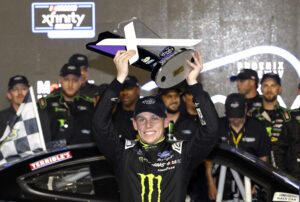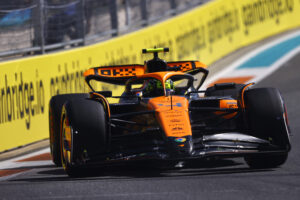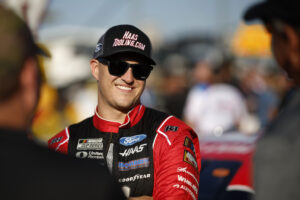Some of F1’s most controversial races and championship battles happened before the 2000s. Take a look back at some of F1’s greatest battles.
Back to a time when the grid was filled with racing legends like Michael Schumacher, Ayrton Senna, and many more. But just as with the current drivers, there were intense battles between the competitors.
3. Michael Schumacher vs. Damon Hill
Adelaide 1994
To this day, debates about the Adelaide Grand Prix 1994 still go on. Did Michael Schumacher cheat or was it just a racing incident?
By the time the schedule reached the last race in 1994, the Adelaide street circuit in Australia, Schumacher led the championship by just one point. Meaning whoever won this race, whether it was Schumacher or Hill, would be the champion. This would be the first championship for each of the drivers.
Schumacher and Hill managed to overtake pole sitter Nigel Mansell on the opening lap. Schumacher in first, Hill in second place.
On Lap 36 Schumacher lost control of his car and slammed into the wall. Nevertheless, he was able to get back on track and continue the race. The incident closed the gap between the two rivals and Hill was suddenly right behind Schumacher, ready to overtake him.
At the next corner, Hill tried to overtake Schumacher on the inside line. Schumacher closed the door, which resulted in a crash between the two. Schumacher’s Benetton got lifted in the air and sent into the wall. Considering both were out of the race by now, it gave Nigel Mansell the chance to win the Australian Grand Prix.
In the end, it was Michael Schumacher, who decided the championship battle for himself, even by just one point. Schumacher claimed he did not sabotage the race. My people speculated that it was a calculated move to win the title.
#F1 1994 Australian GP, Adelaide : Damon Hill vs Michael Schmacher. (ph: https://t.co/5xtGuoMMsP) pic.twitter.com/Lh1hDSX45x
— Autolima (@autolimasrl) August 5, 2016
2. Niki Lauda vs. James Hunt
A beautiful rivalry between two individuals that couldn‘t be more different. 1976 was a high point in both of their careers with a lot of up and downs. Nevertheless, they were never ‘rivals‘ as you‘d imagine. Throughout their rivalry, they were always friends, even way before Formula 1.
1976 – The High Point
Hunt in the McLaren and Lauda in the seemingly unbeatable Ferrari. Lauda had an immense advantage after the first six races, leading with 48 points. With four DNFs and only 15 points, Hunt didn‘t have a good start to the season.
The turning point in this battle was the German Grand Prix. Located in Western Germany and surrounded by dense forests, the Nürburgring was nicknamed ‘Green Hell’ by former F1 driver Jackie Stewart. The track is known for being a rather dangerous circuit. Many drivers have died racing there. Lauda called a meeting, stating exactly that it was simply too dangerous to race there. He didn‘t win the debate and the race was held anyway.
On the second lap, it happened. Lauda had a near-fatal crash in the Bergwerk corner. At a speed of approximately 220 kph, he lost control of his Ferrari, spun, and hit the walls. His car spun back to the track and fire erupted from the car. Lauda was trapped in the flames. Two others crashed into Lauda’s car, Brett Lunger and Arturo Merzario. The latter managed to pull Lauda out of the flames, saving his life. Lauda‘s helmet flew off during the crash, causing severe burns overall, to his body and face.
At the hospital, Lauda was put into a coma. The situation looked bad. Everyone, including doctors and priests, thought he wouldn’t make it.
Niki Lauda's Ferrari after his crash at the Nurburgring GP, 1976 pic.twitter.com/pucKTo3480
— Sports & Betting History by BestBettingSites (@CDCHistory) June 10, 2019
The Return of the Dead
Unbelievably Lauda survived and would return to F1 just six weeks after his accident. With his face wrapped in a blood-soaked bandage, he celebrated his comeback at the Italian Grand Prix with a fourth-place finish. It‘s undeniably the best comeback in F1 history.
After the race in Monza, Lauda still had an 18-point advantage over Hunt. After the following races, James Hunt managed to close the gap to three points. It all came down to the last race of 1976, the Japanese Grand Prix. On the second lap, Lauda stopped the car. Due to the rainfall and complications with his injuries, he claimed it was too dangerous to continue under such circumstances. Lauda’s decision handed Hunt the win that won him the title.
For Hunt, it was the only championship win in his career. Lauda would go on to win two more titles (1977, 1984) in addition to his first one in 1975. The two drivers remained friends until Hunt’s death in 1993. Niki Lauda passed away in May 2019 at the age of 70.
1. Alain Prost vs. Ayrton Senna
They were teammates for McLaren in 1988 and 1989. But their rivalry peaked at Suzuka in 1989, when they fought for the championship.
San Marino Grand Prix 1989
The tension between the two reached another level in the second race of 1989, the San Marino Grand Prix. Before the race started the team agreed that whoever was ahead in the opening lap would not be attacked by the other. Senna took the lead on the opening lap, meaning Prost would not be allowed to overtake him.
On Lap 4 Gerhard Berger caused a Red Flag. The Austrian crashed, his car completely on fire. However, he got away with just a few minor burns, cracked ribs, and some bruises. At the race restart it was Prost who took the lead. Senna thought he had the right to overtake him, considering he led on Lap 1 at the official race start. The team confirmed that Senna was in the right. Prost felt disadvantaged, and their rivalry reached its boiling point.
Japanese Grand Prix 1989
The most discussed turning point in their relationship is the Japanese Grand Prix in 1989. Senna knew he had to win to have a chance in the championship battle. Meanwhile, for Prost, there was still a chance to win the title, even with zero points in Suzuka.
Senna took pole position, 1.7 seconds ahead of his teammate Alain Prost. At the beginning of the race, Prost had a better start than Senna and even managed to put an almost six seconds gap between him and his rival. Throughout the race, Senna managed to close that gap to Prost.
On Lap 47, Senna tried to make a move on his teammate on the inside at the chicane. Prost pulled his McLaren into the side of Senna, causing a collision. While Prost walked away from his car, Senna kept the car running, took the escape road, and headed into the pits. Prost claimed the title despite retiring after Senna was disqualified from the race after he missed the chicane.






